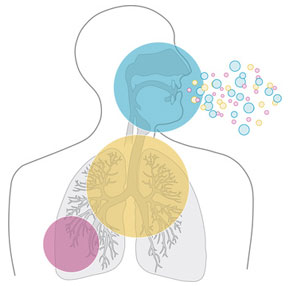Technology
 ASI’s Sensors utilize Carbon Nanotube (CNT) technology, enabling application specific sensitivity and selectivity for hundreds of gaseous compounds in a variety of products. The single-walled carbon nanotube (SWNT) is essentially a rolled-up graphite sheet, and provides unique characteristics which enable extraordinarily high levels of sensitivity. Because CNTs are composed of surface atoms, molecular adsorbates can significantly alter their electronic properties. Further, electrical current flows along the surface of a carbon nanotube, exhibiting near-ballistic electron transport along the tube axis. This results not only in a high current density, but also a high degree of sensitivity to environmental perturbations (compared with a standard semiconductor). The ballistic electron transport properties provide a high-quality electrical conduit for direct transmission of such electrical signals to external contacts. By applying suitable functional layers on the surface of these CNTs, without altering sensitivity, selectively is achieved between unique VOC patterns.
ASI’s Sensors utilize Carbon Nanotube (CNT) technology, enabling application specific sensitivity and selectivity for hundreds of gaseous compounds in a variety of products. The single-walled carbon nanotube (SWNT) is essentially a rolled-up graphite sheet, and provides unique characteristics which enable extraordinarily high levels of sensitivity. Because CNTs are composed of surface atoms, molecular adsorbates can significantly alter their electronic properties. Further, electrical current flows along the surface of a carbon nanotube, exhibiting near-ballistic electron transport along the tube axis. This results not only in a high current density, but also a high degree of sensitivity to environmental perturbations (compared with a standard semiconductor). The ballistic electron transport properties provide a high-quality electrical conduit for direct transmission of such electrical signals to external contacts. By applying suitable functional layers on the surface of these CNTs, without altering sensitivity, selectively is achieved between unique VOC patterns.
 CNT sensors are ideal for measuring not only chemical compounds in the environment, but also minute concentrations of VOCs captured from human breath. Exhaled breath from humans consists of thousands volatile organic compounds (VOCs) in addition to standard gases ( N2, CO2, O2, etc). Detection of these gases and VOCs can help predict several physiological conditions in the human body. When cells metabolise they produce a set of VOCs that are also found in the blood. A part of these VOCs diffuse through the lungs and are exhaled through the breath. Cellular metabolic processes of diseased cells release a unique pattern of VOCs that are different from healthy cells. By identifying breath VOC patterns, it is possible to diagnose for cancer and other diseases. VOCs are usually present in low parts per billion ranges and require very sensitive devices that are also selective to large background interference from CO2, N2, O2 and humidity. CNTs have been proven to be the most cost effective mechanism for providing reliable low power sensors for medical, consumer and industrial applications.
CNT sensors are ideal for measuring not only chemical compounds in the environment, but also minute concentrations of VOCs captured from human breath. Exhaled breath from humans consists of thousands volatile organic compounds (VOCs) in addition to standard gases ( N2, CO2, O2, etc). Detection of these gases and VOCs can help predict several physiological conditions in the human body. When cells metabolise they produce a set of VOCs that are also found in the blood. A part of these VOCs diffuse through the lungs and are exhaled through the breath. Cellular metabolic processes of diseased cells release a unique pattern of VOCs that are different from healthy cells. By identifying breath VOC patterns, it is possible to diagnose for cancer and other diseases. VOCs are usually present in low parts per billion ranges and require very sensitive devices that are also selective to large background interference from CO2, N2, O2 and humidity. CNTs have been proven to be the most cost effective mechanism for providing reliable low power sensors for medical, consumer and industrial applications.
